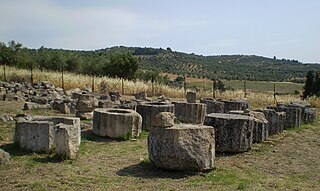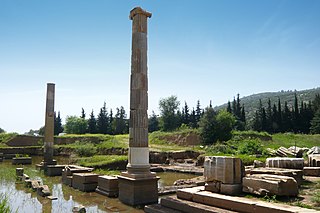
Abae was an ancient town in the northeastern corner of ancient Phocis, in Greece, near the frontiers of the Opuntian Locrians, said to have been built by the Argive Abas, son of Lynceus and Hypermnestra, and grandson of Danaus. This bit of legend suggests an origin or at least an existence in the Bronze Age. Its protohistory supports a continued existence in Iron-Age antiquity. It was famous for its oracle of Apollo Abaeus, one of those consulted by Croesus, king of Lydia, and Mardonius, among others. The site of the oracle was rediscovered at Kalapodi and excavated in modern times. The results confirm an archaeological existence dating from the Bronze Age, as is suggested by the lore.

Delphi, in legend previously called Pytho (Πυθώ), was an ancient sacred precinct and the seat of Pythia, the major oracle who was consulted about important decisions throughout the ancient classical world. The ancient Greeks considered the centre of the world to be in Delphi, marked by the stone monument known as the Omphalos of Delphi (navel).

Ephesus was a city in Ancient Greece on the coast of Ionia, 3 kilometres (1.9 mi) southwest of present-day Selçuk in İzmir Province, Turkey. It was built in the 10th century BC on the site of Apasa, the former Arzawan capital, by Attic and Ionian Greeks. During the Classical Greek era, it was one of twelve cities that were members of the Ionian League. The city came under the control of the Roman Republic in 129 BC.

Pythia was the name of the high priestess of the Temple of Apollo at Delphi. She specifically served as its oracle and was known as the Oracle of Delphi. Her title was also historically glossed in English as the Pythoness.

Caesarea, also Caesarea Maritima, Caesarea Palaestinae or Caesarea Stratonis, was an ancient and medieval port city on the coast of the Eastern Mediterranean, and later a small fishing village. It was the capital of Roman Judaea, Syria Palaestina and Palaestina Prima, successively, for a period of c.650 years, and a major intellectual hub of the Mediterranean, from the time of Herod I until the Muslim conquest of the Levant. Today, the site is part of the Caesarea National Park, on the western edge of the Sharon plain in Israel.

Olympia, officially Archaia Olympia, is a small town in Elis on the Peloponnese peninsula in Greece, famous for the nearby archaeological site of the same name. This site was a major Panhellenic religious sanctuary of ancient Greece, where the ancient Olympic Games were held every four years throughout Classical antiquity, from the 8th century BC to the 4th century AD. They were restored on a global basis in 1894 in honor of the ideal of peaceful international contention for excellence.

Yavne or Yavneh is a city in the Central District of Israel. In 2022, it had a population of 56,232.

Helike was an ancient Greek polis (city-state) that was submerged by a tsunami in the winter of 373 BC.

Paestum was a major ancient Greek city on the coast of the Tyrrhenian Sea, in Magna Graecia. The ruins of Paestum are famous for their three ancient Greek temples in the Doric order dating from about 550 to 450 BC that are in an excellent state of preservation. The city walls and amphitheatre are largely intact, and the bottom of the walls of many other structures remain, as well as paved roads. The site is open to the public, and there is a modern national museum within it, which also contains the finds from the associated Greek site of Foce del Sele.

Elaiussa Sebaste or Elaeousa Sebaste was an ancient Roman town located 55 km (34 mi) from Mersin in the direction of Silifke in Cilicia on the southern coast of Anatolia.

Letoon or Letoum in the Fethiye district of Muğla Province, Turkey, was a sanctuary of Leto located 4 kilometres (2.5 mi) south of the ancient city of Xanthos, to which it was closely associated, and along the Xanthos River. It was one of the most important religious centres in the region though never a fully-occupied settlement.

Aigai, also Aigaiai, was an ancient Greek, later Roman, city and bishopric in Aeolis. Aegae is mentioned by both Herodotus and Strabo as being a member of the Aeolian dodecapolis. It was also an important sanctuary of Apollo. Aigai had its brightest period under the Attalid dynasty, which ruled from nearby Pergamon in the 3rd and 2nd century BC.

Claros was an ancient Greek sanctuary on the coast of Ionia. It contained a temple and oracle of Apollo, honored here as Apollo Clarius. It was located in the territory of Colophon, which lay twelve kilometers to the north, one of the twelve cities of the Ionian League. The coastal city Notion lay two kilometers to the south. The ruins of the sanctuary are now found north of the modern town Ahmetbeyli in the Menderes district of Izmir Province, Turkey.

The Temple of Apollo, also known as Apollonion, was a major part of the Panhellenic religious sanctuary located in Central Greece at Delphi. The temple and sanctuary at large were dedicated to one of the major Greek deities, Apollo, the god of archery, music, light, prophecy, the arts, and healing. There have been several temples built at Delphi throughout the history of the site, though the visible ruins seen in modernity are those of the temple built in the 4th century B.C.E. before its destruction under the orders of Theodosius I in 390 C.E.. During antiquity, the temple was home to the famous Greek prophetess the Pythia, or the Oracle of Delphi, making the Temple of Apollo and the sanctuary at Delphi a major Panhellenic religious site as early as the 8th century B.C.E., and a place of great importance at many different periods of ancient Greek history. References to Delphi, the sanctuary, the temple, and the prophecies of the Pythia are made throughout ancient Greek mythology and historical accounts from the periods of its use.

Kalapodi is a village in the Lokroi municipality, Phthiotis, Central Greece. Lokroi straddles the pass leading over the low mountains between the Bay of Atalantis in the Gulf of Euboea to the plains of Boeotia north of Lake Copais. The road is often termed the Atalanti-Livadeia. The community of Atalanti, the chief deme of Lokroi, overlooks the Bay of Atalantis, while Livadeia is the current capital of Boeotia.

Chorazin or Korazim was an ancient village in the Roman and Byzantine periods, best known from the Christian Gospels. It stood on the Korazim Plateau in the Upper Galilee on a hill above the northern shore of the Sea of Galilee, 2.5 mi (4.0 km) from Capernaum in what is now the territory of modern Israel.
The Ottomans finalized their domination over Phocis and Delphi in ca. 1410. Delphi itself remained almost uninhabited for centuries. It seems that one of the first buildings of the early modern era was the monastery of the Dormition of Mary or of Panagia built above the ancient gymnasium. It must have been towards the end of the 15th or in the 16th century that a settlement started forming there, which eventually ended up forming the village of Kastri.
Archaeological investigation in Delphi started in the second half of the 19th century, but it was not until 1892 when a systematic excavation began under the direction of Théophile Homolle and the French Archaeological School of Athens. The "Great Excavation" lasted 10 years and was concluded by the creation of the first museum on-site. In the years to follow, the site never ceased to be excavated and investigated. Several of the monuments were restored and new interpretations continue to see the light in the academic field.

The modern town of Delphi is situated immediately west of the archaeological site of the same name. The town was created as a home for the population of Castro, which was relocated to allow for the excavation of the site of ancient Delphi. The importance of the twin locations grew to the point where Delphi has also been made the name of the modern-day municipality, which includes the communities of the Plaistos valley system as far south as the Gulf of Corinth. The name Delphi came from the Oracle of Delphi, which was anciently accepted as a purveyor of truth revealed by the god Apollo.

The Decauville railway in Delphi was a 3 km (1.9 mi) long 500 mm gauge light railway used from 1892 to 1903 on the archaeological excavation site of the ancient temple complex of Delphi in Greece.


















